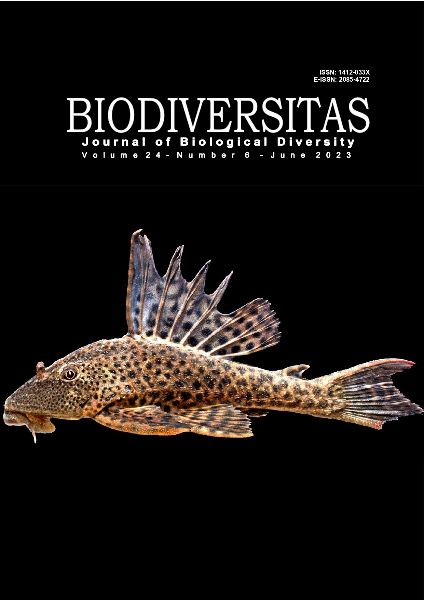Surface ultrastructure of tick (Acari: Ixodidae) on Moa buffalo from Southwest Maluku District, Indonesia
##plugins.themes.bootstrap3.article.main##
Abstract
Abstract. Utami P, Kunda RM. 2023. Surface ultrastructure of tick (Acari: Ixodidae) on Moa buffalo from Southwest Maluku District, Indonesia. Biodiversitas 24: 3230-3235. Moa buffalo is one of the local Indonesian buffalo families in the Southwest Maluku District with very limited distribution and is found only on Moa Island. It exhibits distinct characteristics that distinguish it from clumps of mud buffalo and other local breeds, making it a valuable local livestock resource in Indonesia. Meanwhile, ticks are obligatory hematophagous ectoparasites with direct effects on the host, such as blood and weight loss, and their indirect effects are more associated with their role as vectors of disease-carrying pathogens. This study aimed to identify ticks infesting Moa buffalo by analyzing their surface ultrastructure using a Scanning Electron Microscope (SEM) method. This method enabled the establishment of the taxonomic status to obtain comprehensive data regarding the mapping of tick species in Moa buffalo. The samples were manually collected, and the body of the cattle was divided into four regions to determine the preferred attachment sites of ticks. The head, back, tail, and legs were all carefully examined, and each tick was carefully picked from the surface using tweezers or a pair of thumb forceps. Furthermore, the tick samples were collected from three different parts of the Moa buffalo's body, namely the armpit, inguinal region, and perianal area. Based on observations of morphological characters, the ticks found in Moa buffalo were of two species, namely Dermacentor auratus Supino, 1897 and Haemaphysalis bispinosa Neumann, 1897. The Dermacentor genus, specifically D. auratus exhibited specific morphological characteristics, including a pair of eyes located at the coxae II level, an ornate scutum, capitulum, and feet, as well as a short hypostome with 3:3 tooth arrangement. Members of this genus also had festoons, with the size of coxae increasing from I to IV. On the other hand, H. bispinosa was characterized by underdeveloped cornua. The segments of palpal III, for both males and females exhibited posterodorsal and posteroventral protrusions. The posteroventral segment of palpal III formed a wide and blunt triangle in both sexes, while the palpal III section had wide median spurs. These characteristics were keys for the identification of H. bispinosa species.
##plugins.themes.bootstrap3.article.details##
Most read articles by the same author(s)
- ANA SAHARA, BAMBANG HERU BUDIANTO, RONY MARSYAL KUNDA, LINTANG WINANTYA FIRDAUSY, Tick (Acari: Ixodidae) infestation in cattle from Sleman, Yogyakarta Province, Indonesia , Biodiversitas Journal of Biological Diversity: Vol. 24 No. 7 (2023)


 https://orcid.org/0000-0001-5054-3722
https://orcid.org/0000-0001-5054-3722